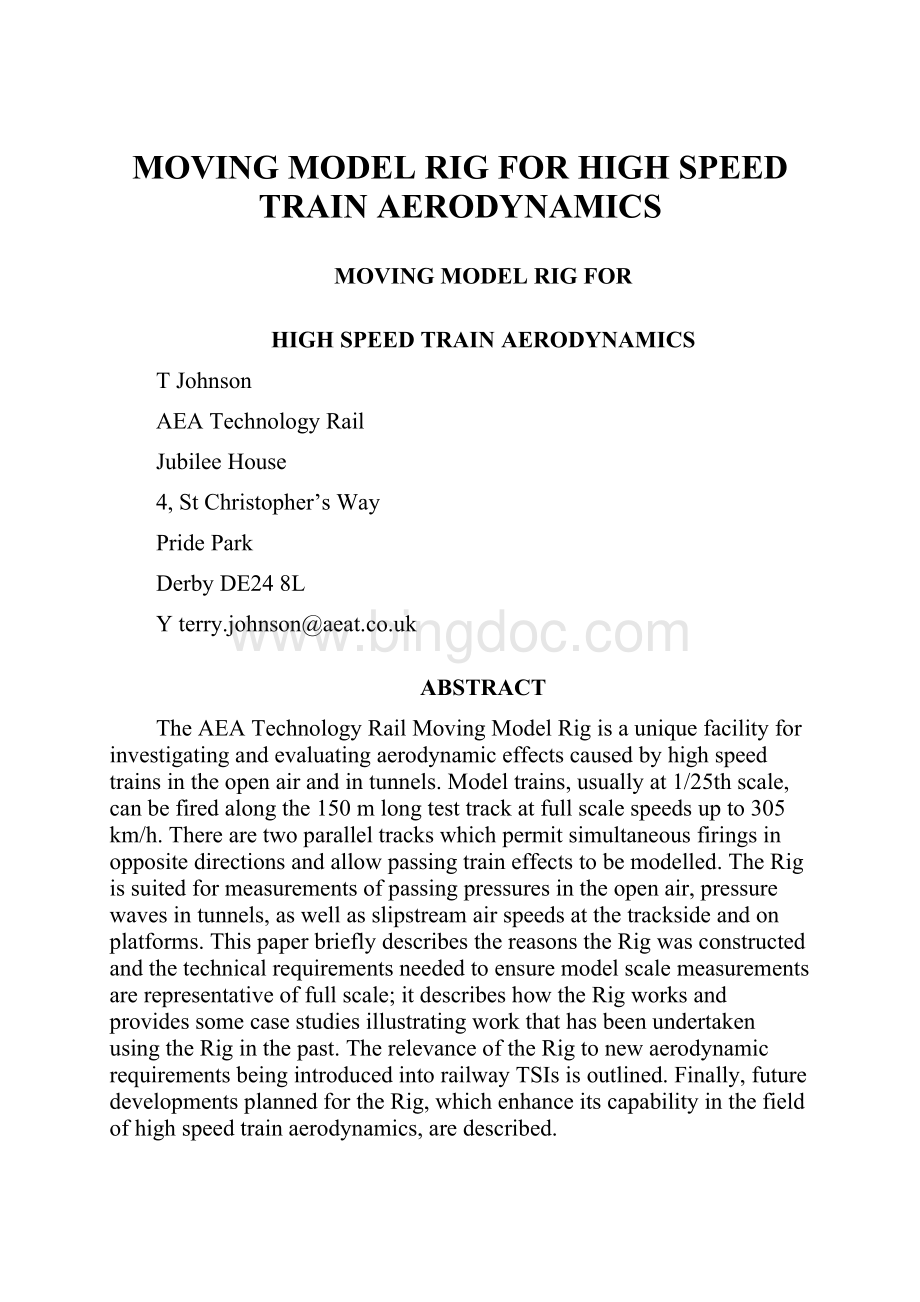MOVING MODEL RIG FOR HIGH SPEED TRAIN AERODYNAMICS.docx
《MOVING MODEL RIG FOR HIGH SPEED TRAIN AERODYNAMICS.docx》由会员分享,可在线阅读,更多相关《MOVING MODEL RIG FOR HIGH SPEED TRAIN AERODYNAMICS.docx(13页珍藏版)》请在冰点文库上搜索。

MOVINGMODELRIGFORHIGHSPEEDTRAINAERODYNAMICS
MOVINGMODELRIGFOR
HIGHSPEEDTRAINAERODYNAMICS
TJohnson
AEATechnologyRail
JubileeHouse
4,StChristopher’sWay
PridePark
DerbyDE248L
Yterry.johnson@aeat.co.uk
ABSTRACT
TheAEATechnologyRailMovingModelRigisauniquefacilityforinvestigatingandevaluatingaerodynamiceffectscausedbyhighspeedtrainsintheopenairandintunnels.Modeltrains,usuallyat1/25thscale,canbefiredalongthe150mlongtesttrackatfullscalespeedsupto305km/h.Therearetwoparalleltrackswhichpermitsimultaneousfiringsinoppositedirectionsandallowpassingtraineffectstobemodelled.TheRigissuitedformeasurementsofpassingpressuresintheopenair,pressurewavesintunnels,aswellasslipstreamairspeedsatthetracksideandonplatforms.ThispaperbrieflydescribesthereasonstheRigwasconstructedandthetechnicalrequirementsneededtoensuremodelscalemeasurementsarerepresentativeoffullscale;itdescribeshowtheRigworksandprovidessomecasestudiesillustratingworkthathasbeenundertakenusingtheRiginthepast.TherelevanceoftheRigtonewaerodynamicrequirementsbeingintroducedintorailwayTSIsisoutlined.Finally,futuredevelopmentsplannedfortheRig,whichenhanceitscapabilityinthefieldofhighspeedtrainaerodynamics,aredescribed.
KEYWORDS:
Aerodynamics,modelling,testing,highspeedtrains,pressures,airspeed,tunnels
INTRODUCTION
Intheearly1980’saneedforamovingmodeltestfacilityforrailwaytunnelaerodynamicswasrecognisedbyBritishRailResearch.Fullscaletestswereexpensive(andstillare!
),requiredcomplexplanningandlongleadtimesandwerelabourintensive.Inaddition,theambientconditionswereuncontrollableandthepresenceofadverseweatherconditions,forinstance,wouldofteninvalidateaday’stesting,orattheveryleast,addanuncertaintyintotheanalysisoftheresults.Finally,testingwaslimitedtotrainsthatwerealreadybuiltandinfrastructurethatwasalreadyinplace,limitingthepotentialforinvestigating‘what-if’designs.DespitetherapidgainsinknowledgeofrailwayaerodynamicsmadetothatdatebyBritishRailResearch,theoreticalandcomputationalmethodswerestillinadequatetoinvestigateaerodynamicproblemssufficientlywelltoobviatetheneedfortesting.
Thetechnicalrequirementsformodelscaletestingofrailwayaerodynamicswereeasilyestablished:
Reynolds’numberandtrainMachnumberhadtobenearenoughtofullscalevaluestoensurethatthemodelscaleresultswouldberepresentativeoffullscale.TheReynolds’numberensuresthatscaleeffectsarenotimportantandthetrainMachnumberensuresthatpressurewaves,generatedwhenatrainentersatunnel,behaveinthesamephaseastheirfull-scaleequivalents.FromtheextensivewindtunneltestexperienceoftheBritishRailResearchstaff,itwasknownthatReynolds’numbereffectswouldbesmallifascaleofgreaterthanabout1/30thwasused.ThetrainMachnumber,(ietrainspeeddividedbyspeedofsoundinair),couldonlybematchedtofullscaleiffullscaletrainspeedswereused,(ignoringexoticwaystochangethespeedofsound).Finallytherigwasbuilttoaccommodate1/25thscaletrainmodels(orlargerifrequired)travellingatspeedsupto200km/h.Thefirstversion,consistingofasinglefiringtrackwascompletedin1988.DevelopmentoftheMovingModelRig(MMR)hascontinuedsince1991,drivenbytheincreaseintrainspeedsprimarilyinEurope,butalsointheUK.AmajorextensionoftheMMR’scapabilitywastheadditionofasecondfiringtrack,permittingstudiesofpassingtrainsattwodifferenttrackseparations.Thiswascompletedin1992.FurtherdetailsoftheMMRdevelopmentarereportedbyDalleyandJohnson(1999).
AlthoughthereareothermovingmodelfacilitiesforthestudyofrailwaytunnelaerodynamicsinJapanandtheNetherlands(DalleyandJohnson,1999),theMMRisuniqueinseveralaspects.Theotherfacilitiesuseaxi-symmetrictrainmodelswhichcorrectlyrepresentthecross-sectionalareaevolutionofthetrainsbeingstudied,andthesearefiredalongwiresthroughthecentreofpipesrepresentingthetunnelsofinterest.Thesefacilitiesareusedtostudypressurewavephenomenainrailwaytunnels.Bycontrast,theMMRhasrealisticallydetailedtrainmodelsthatrunalongtracksfittedalongthebottomofthetunnel,muchasinreallife.Thisallowstheeffectoftraindesigndetailstobeaccuratelycapturedaswellasmodellingthecorrectrelationshipbetweenthetrainandtheground.Furthermore,theMMRisafacilitywhichisnotjustlimitedtothestudyofrailwaytunnelaerodynamics,butcanalsobeusedtostudytheaerodynamicphenomenageneratedbytrainsrunningintheopenair.
MECHANISMOFTHEMMR
Overview
TheMMRconsistsoftwoparallelfiringtrackswithoveralllengthof150m.Athirdtrack,atawidertrackspacingisalsoinplaceandcanbeconfiguredtoallowmodelstofiredalongit.Thereisacentraltestsectionof50minlength.Eitherendofthetestsectionthereisanaccelerationsectionandabrakingsection,eachabout50mlong.Theparalleltracksallowmodelstobefiredfromoppositeendsiftraincrossingeffectsareofinterest.
Thecentraltestsectionhasabuilt-upflooronwhichmodeltunnelscanbelocatedfortunnelaerodynamictesting.At1/25thscale,thisallowstunnelsuptoafull-scalelengthof1250mtobemodelled.Suchtunnelsneedtobecarefullypressure-sealedtothetestsectionbasetoensurethatthereisnoleakagetoatmosphereofthetrain-generatedpressuresfromthetunnelsduringtesting.
Oncethemodelhasbeenlaunched,itwilltravelatapproximatelyconstantspeedoverthetestsection,unlessthereisamodeltunnelinplace.Inthiscase,thetrainlosesabout1-2m/sinspeedduetotheincreasedaerodynamicresistanceinthetunnel.
Realistictrainmodels,usuallybuiltto1/25thscale,aretestedontheMMR.Theyareusuallyoffourvehiclesupto4minlength,whichnormallyisadequatefortheinvestigationoftrainaerodynamics,inordertolimitmodelweight.Themodelsthemselvesareconstructednowadaysusinglightweightexpandedfoam,shapedusinganaccuratelymanufacturedmould.Theyarebuiltaroundanaluminiumchassisattachedtowheelsonwhichthemodelactuallyruns.Thetrainbogiesandwheelsareconstructedfrombalsawoodandareattachedtothemodeltrains.Othermaterialswereusedinthepastformodelconstruction,butfoamoffersagoodcompromisebetweenstrength,weightandeaseofreplacement.Typicalmodelweightsarebetweenthreeandeightkilogrammes.AtrainmodelisshownontheMMRinFigure1.
Figure1TrainmodelontheMovingModelRigatDerby
Duetotherealismofthetrainmodels,aerodynamicmeasurementsontheMMRhavebeenfoundtoreplicatefullscaleveryaccurately,aswillbeshowninthebriefcasestudiespresentedlaterinthispaper.Onlyintheunderbodyregionofthetrain,betweenthetracks,doestheflowaroundthemodeltrainnotreplicatefullscale.Thisisduetothemodelstracks,whichdonotmodelrealrails,astheyarerequiredtorestrainthemodelfromliftingduringacceleration,andthechassiswheels.
AccelerationSection
Thetrainmodelsarepoweredby,whatisineffect,abungeerubbercatapult.Severallargeelasticbungeecordsaretensionedtogetherusinganelectricwinchpriortomodellaunch.Typically,thebungeesareloadedbetween7-11kN,dependingontheweightofthemodelandthespeedrequiredforthemodelrun.Whenreleased,theenergystoredinthebungeesistransmittedviaafiringcordpassingthroughacomplexpulleygearingsystemtothemodel,whichisthenaccelerateduptospeedintheaccelerationsection.Asthetrainmodelreachesacertainpointalongtheaccelerationsectionthecord,whichisattachedtoahookunderthemodel,dropsoffandthemodelproceedstocoastalongthetrackstothetestsection.
Thepulleygearingsystemisneededtocontroltheratethattheenergyistransmittedtothemodel,whichwouldotherwisebedamagedbytheacceleration.Thetopspeedachievedusingafullmodelis305km/halongthetestsection.
TheschematicoftheMMR,showninFigure2,showstheaccelerationsectionandmechanisminmoredetail.
MovingModelRig
Figure2SchematicoftheMovingModelRig,showingtheaccelerationandbrakingsystems
BrakingSection
Oncethemodelhaspassedthroughthetestsection,itentersthebrakingsection.Here,ahookunderthetrainmodelpicksupacordattachedtoapistonviaasecondpulleysystem.Themovingmodeldrawsthepistonintoadeformabletube,anditisthedeformationenergywhichcausesthemodeltoslowdownandstop.Again,apulleygearingsystemisnecessarytoreducethebrakingrateandtominimisedamagetothetrainmodel.Figure2showsmoredetailsofthebrakingsectionandbrakingmechanism.
Instrumentation
MeasurementsareusuallymadeontheMMRusingground-basedinstrumentation,mountedeitherattracksideorinthemodeltunnels.Fourteenchannelsofmeasurementdatacanbeloggedsimultaneously.Pressuretransducersareusedforpressuremeasurements,andeightchannelsofhotwireanemometryarealsoavailableformeasuringairspeeds.Trainpositionandspeedismeasuredusinglasereventdevicesatthestartofthetestsection.Highdatasamplingratesarerequiredaseventsoccurat25timesfasterthanreallifeforascaleof1/25th.
Bespokesoftwarecontrolstensioningthebungees,modelfiring,safetyanddataacquisition.Allsignalsaredigitisedandrecordedusingthesamesystem,whichallowsthemeasurementdatatobeviewedstraightaftereachrunforcheckingpurposes.
Thereisal